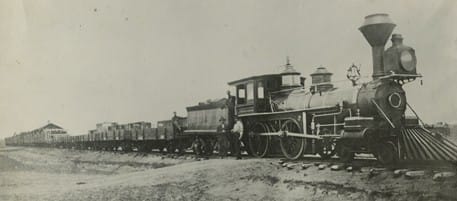On September 15, 1869, the first railroad to enter this state to serve just Colorado Territory was the Denver Pacific. It covered the hundred miles between Cheyenne and Denver, routed through the railroad town of Evans. Track laying began in Cheyenne, crossing the northern boundary of Colorado in October, and reaching Evans just north of the South Platte River in December.
This changed everything for the area of modern Weld County. In April of 1870 the town of Greeley was situated along this track between the Cache la Poudre and South Platte Rivers so they could have irrigated lands with easy rail service to bring in and take out people and goods.
To complete the track to Denver, the laying of rails began on the South Platte River Bridge at Evans on May 8, 1870, and the project was finished by the end of June. Regular freight and passenger service began immediately between Greeley and the rest of the country connected by rail.
In 1877, the Union Pacific Railroad (UP) began working on monopolizing Colorado railroad traffic, eventually purchasing the Denver Pacific and the Kansas Pacific and leasing the Colorado Central Rail Road Company (CCRR). To thwart this plan, in 1879 the Burlington Railroad started constructing a rail way into Colorado from Nebraska, eventually building into today’s Weld County along the South Platte River into Denver.
The Weld towns that started on, or moved to the Denver Pacific track by 1883 were (from north to south) Athol, Lone Tree, Carr, Pierce, Eatonton (Eaton), Greeley, La Salle, Platteville, Johnson and Fort Lupton.
Then in early 1881 a new Colorado railroad company was incorporated, backed by the UP, called the Greeley Salt Lake & Pacific (GSL&P). Their initial plan was to construct railroad track from Greeley to Fort Collins, up the Poudre Canyon, across North Park, into Utah and finally – the California Coast.
The GSL&P charter was amended to allow them to build narrow gauge railroad lines up several canyons in the Front Range. In the Poudre Canyon GSL&P surveyed with UP crews. Their representatives asked both Fort Collins and Greeley for free rights of way through town. The resulting hubbub inspired Fort Collins’ citizens to falsely believe their town would become a major stop on a planned transcontinental railroad line. Greeley citizens were only expecting what they actually got, direct trade from the foothills, especially forest products and stone.
By February of 1882, GSL&P completed 15 miles of track from Fort Collins to Stout (site is now under Horsetooth Reservoir), hauling out carloads of stone from rock quarries owned by UP.
Later that year, the GSL&P line was completed between Fort Collins and Greeley, with the last rail spike hammered down in Greeley on October 4th. Mixed train service began immediately between Greeley and Stout, and within 6 weeks a daily train ran between Fort Collins, Greeley and Denver. Many of the sidewalks in Greeley, Denver, Omaha, Lincoln, Topeka and Kansas City were made from Stout stone.
Since there were no minerals found up Poudre Canyon further railroad construction up the canyon was halted. By fall of 1882 the idea of a transcontinental line connecting Greeley to the Pacific was dropped. The GSL&P finished a narrow gauge railroad line from Boulder to Fourmile Canyon and Pennsylvania Gulch in 1883. Then a standard gauge line was built by GSL&P from Fort Collins south to the coal mining fields near Erie that connected to Denver. Another line ran from Loveland eight miles northwest to quarries at Buckhorn (later named Arkins) above Masonville Road.
Despite GSL&P successes in hauling stone and railroad ties, and connecting many Front Range towns, the Greeley, Salt Lake and Pacific Railroad Company was short-lived. By the end of 1885 timber sources up Poudre Canyon were all but depleted. Numerous accidents hauling stone, labor troubles at the quarries and a decline in stone prices took their toll.
On April 1, 1890, GSL&P was one of twelve railroad companies combined into a consolidated railroad system, the Union Pacific, Denver & Gulf Railway Company (UPD&G). Within three years UPD&G was bankrupt. They were taken over in 1899 by the newly formed Colorado and Southern Railway (C&S). The C&S remained independent until 1908 when it became part of the Chicago, Burlington and Quincy Railroad that was absorbed into the Burlington Northern Railroad in 1981.
To find out more about the history of transportation in Northern Colorado, visit the Hazel E. Johnson Research Center.
Originally published in the Greeley Tribune on June 5th, 2009.
Written by Nancy Lynch, former curator of exhibits.
